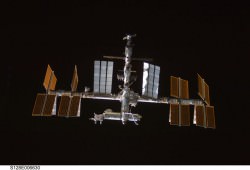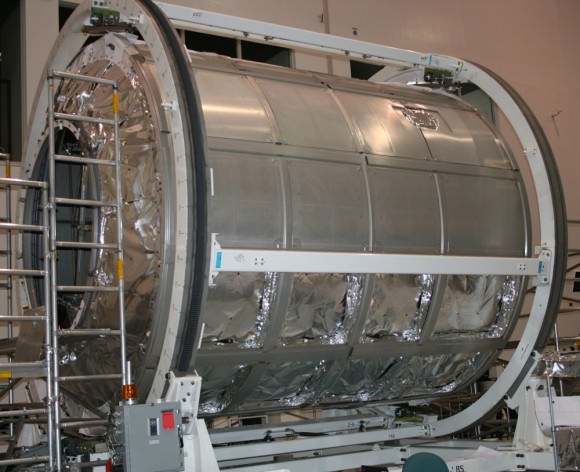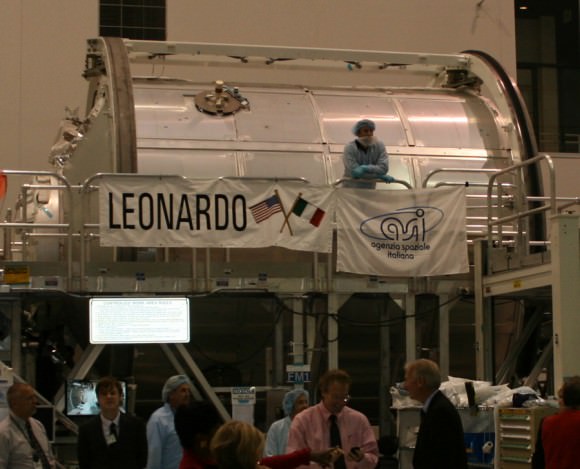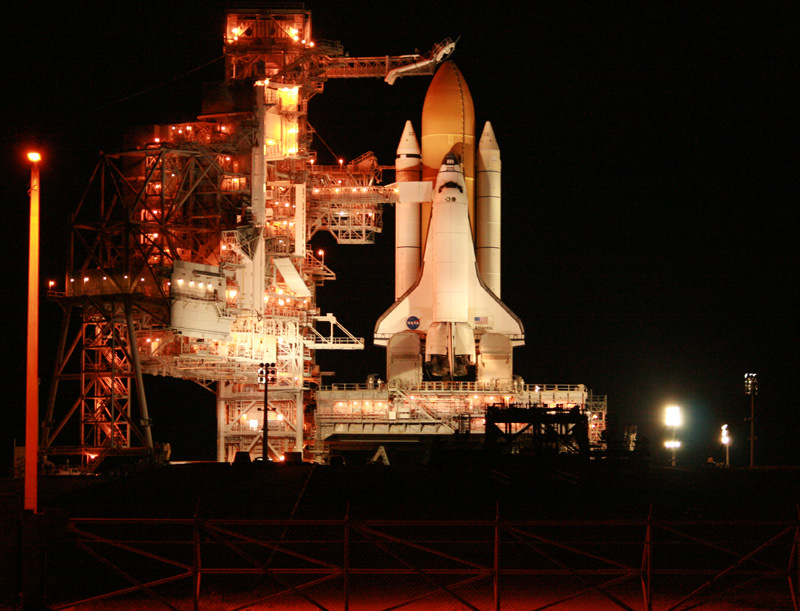Space Shuttle Atlantis sits poised for the STS 129 launch from Pad 39 A on 16 November 2009. Atlantis would likely fly a proposed new flight as STS-135. Credit: Ken Kremer
The end of the Space Shuttle Era is rapidly approaching and with it some urgent questions including, “How will the US support continued use of the ISS?” and “What would NASA do if granted an additional shuttle flight?”
Currently, only 5 flights remain on the manifest and right now, the final shuttle flight is set for September 2010. This deadline and policy was decreed by the Bush Administration and simultaneously coincides with the end of ISS assembly and the end of the Fiscal 2010 budget year. Thus far the Obama Administration has not announced any policy changes despite recurring questions from Congress and the press as the retirement approaches.

Then comes the big “gap” in US human spaceflight launch capability between the looming shuttle shutdown and the debut of the Orion capsule. Orion will not be ready until 2015 or later. So there will be a minimum 5 year “gap” when NASA cannot launch its own astronauts or even unmanned cargo supply vessels to the International Space Station which will operate until at least 2015. Hence the practical questions from the US side on “How to re-supply the ISS?”
NASA will then be utterly dependent on Russia to launch US astronauts to the ISS at a cost of some $50 million per Soyuz seat. Several companies are receiving NASA funding under the COTS program to develop cargo up-mass vehicles to the ISS and are also exploring crewed options.
For the most part, the general public is unaware of these facts. Congress has been fully aware of this quandary since 2004 when President Bush announced new NASA goals as part of the VSE or “Vision for Space Exploration” to return to the Moon and beyond to Mars. NASA’s budget has been cut in the intervening years and the “gap” has grown longer. Insufficient funding from Washington, DC directly caused a slower development pace for Orion and the Ares rocket.
One much discussed “gap” closing measure is to slightly extend the deadline for closing out the shuttle program by adding 1 or more new flights. This action requires a direct decision soon from President Obama and enabling funding from Congress.
If granted the authority to extend the Shuttle program with an additional flight, NASA officials at a very high level have already decided on paper what such a mission would entail. Bill Gerstenmaier, NASA Associate Administrator for Space Operations says that the team has done some planning for what is dubbed a ‘contingency’ flight. “It sits on the manifest as a ‘contingency’ if we need to fly it. It would be prudent to have an MPLM (pressurized Multi-purpose logistics module) in there to carry spares and restock station. We originally wanted to have a back up shuttle available in case we had a situation where we needed to do a contingency crew support to keep them in orbit for some period of time.”
At the Kennedy Space Center (KSC), I spoke with Scott Higginbotham about the details of the ‘contingency’ flight. Scott is a shuttle payload mission manager at KSC, most recently for STS-129 . He told me, “If there was to be another mission then the plan is to fly another MPLM. We have two more MPLM’s but only one is flight worthy. For the call up mission, the possible new last flight, we would fly ‘Raffaello’. But NASA needs more money and work modifications to get ‘Raffaello’ ready and up to speed”.

NASA has three MPLM’s total, named ‘Leonardo’, ‘Raffaello’ and ‘Donatello’ after significant engineers in Italian history and the Ninja turtles too. All were built by Alenia in Italy under contract to the European Space Agency (ESA). ‘Leonardo’ will be permanently attached on the current last flight, STS 133, after “beefing up the outside to provide extra micrometeoroid debris protection for the module. That will allow it to stay on orbit,” according to Gerstenmaier. ‘Leonardo’ would then be redesignated as a Permanent Multipurpose Module, or PMM. Initially it will be docked at a space facing port on the Harmony connecting node.
“Since the MPLM’s only go up on short sortie missions, their shielding is not as thick as the other station elements,” said Higgenbotham. ‘Leonardo’ flies once more in March 2010 and will then be modified to add shielding. “Donatello will never fly. It’s become our spare parts man to be raided if needed.” Alenia also constructed the Tranquility and Cupola long duration modules I observed recently at a ceremony inside the KSC Space Station Processing Facility (LINK). While inside the station facility, I inspected all three of the MPLM’s (see photos).
“Because of the limited number of shuttle missions left and budget constraints, it makes more sense financially to just fly ‘Leonardo’ over and over again. ‘Raffaello’ is being maintained just in case” added Higgenbotham. “We know that we would like to fly more supplies to the station and bring things home. But whether we actually go prepare ‘Raffaello’ for that contingency mission is being discussed. So we are doing some of the advanced exercises in case we get turned on.”

“We know the big picture of what would be included. It would include science experiments, spare parts, food, clothing, station consumables and what the crew needs to get by day to day”, he said. “So if I have the ability to launch another MPLM mission, then I can loft thousands of pounds that I don’t need to pay a commercial vendor or the Russians to do,” Higgenbotham explained. “We can save them for other items that may break down in the future.”
Large outside items would probably not go up on that mission. “The expectation is we are going to clear the house of all large external parts by the time the last mission flies. All those are planned for going up on the already manifested missions. We have analyzed what’s needed over the lifetime of the station if we extend out to 2020,” said Higgenbotham.
The station must be continually resupplied with spare parts and logistics for its remaining lifetime whether it’s 2015 or longer to 2020 which is far beyond the upcoming retirement of the Space Shuttle.
“NASA has one External Tank (ET) already built for the ‘contingency’ mission” according to Mike Moses, shuttle integration manager at KSC. Two others exist only in pieces he told me. Since it takes 3 years to build a new ET from scratch, there would be some launch delay for any further missions beyond the possible ‘contingency’ flight.
The future goals of NASA and US human and robotic spaceflight hangs in the balance awaiting critical choices by President Obama and political leaders in Washington, DC. At this point, there is no indication of when President Obama will make a decision on goals or funding. With each day’s delay, the chances to extend the shuttle program are diminished as US manufacturing production lines are shut down, more shuttle workers are layed off and their high technology skills are lost.
About 7000 shuttle workers will lose their jobs at KSC and many more across the US as the Space Shuttle program is terminated in the midst of the current recession.


Well… given what has happened in the intervening years, it was a good thing we decided to invite Russian participation aboard the ISS! WHERE would we be had we not? Do you remember the debates?
MEANWHILE, there are other logs burning in the fire… some apparent and some being kept ‘under wraps’? I note the X-37B, the Klipper Mk II. Also there is renewed interest in ESA’s Hermes and JAXA’s shuttle.. SpaceX’s Dragon and Falcon flights… and more! Watch for a new spacecraft from China!
I’d say add some additional boosters and take the shuttle on a trip around the moon and back. Plenty of space on board for a bunch of astronauts on a 2 week trip, no?
Are any of the shuttle’s non-main-engine engines powerful enough to pull away from earth orbit? Can they be extended with additional fuel tanks stored in the cargo bay?
Or how about making an unmanned launch to test the cargo only variation of the shuttle that has been floated before?
How about putting two shuttles in orbit at the same time? Only one pad can support shuttle launches now. So this extra mission would be launched a few days after the first one but while that one is still in orbit. No idea what that would be good for. Maybe practicing transferring crews between spacecraft? it would be pretty expensive though.
Just a few crazy thoughts for their own sake.
Retiring the shuttle doesn’t bother me, it’s the lack of funding that’ll really slow things down. Would love to see NASA get additional funding, but still retire the shuttle. We need to research and develope more effective ways to get into space other then rockets.
In an ideal world, there would be enough money for both the shuttles and a moon system.
The shuttles could continue low orbit missions (space station, etc) but the schedule could be cut back to only a few launches per year.
I still think the X-33 needs another look.
What I’d like to see happen is continuation of the current development of capsule based systems, from NASA/ESA/Roscosmos/JAXA etc, and then, further work towards lifting body type systems.
These types of aircraft were tested in the 60s, and to me, would make a far more sensible reusable system that a shuttle style aircraft.
From here in Britain I find it sad and utterly depressing that we’re talking about a five year gap in American human space flight. My god, whatever happened to American can-do? If they’re now dependent on the Russians it’s no big deal as cooperation is the way to go but for NASA to stumble into it like this is, I’m afraid to say, rather pathetic.
To shut-down the Space Transportation System known as the Space Shuttle Fleet makes no sense. For a detailed history of the STS locate a book called ENTERPRISE written around 1976.
The Shuttle system was actually built on half the budget Congress and the President at that time, argreed to (Both Nixon and Carter are to blame for the lact of funding support for the STS). Because inflation doubled during Shuttle development, NASA was never given the added funds to make up for the loss of spending power because of inflation.
NOTE: The budget of NASA is still around <1% of the U.S. Federal Budget. NASA and the U.S. Govt needs to keep the Shuttle System active until, at least NASA has its new generation of manned launch vehicles operational.
Eh, what? This is the second time, the gap between Saturn and Shuttle was 1975 – 1981, or six (!) years.
This is simply BAU – Business As Usual.
Understand the shuttle does not have a perfect safety record, but neither did the first ships that sailed the oceans. America’s aversion to failure (not risk), particularly in such a highly visible program, suggest that it is far, far safer for the politicians and corporate proponents to propose a more “ballistic” approach to the space program than an inspired one. Constellation is a step backwards. It is a program looking over its shoulder for glory that was once described as “Spam in a Can”. It will be safe, for sure; at least through the next elections. The argument to jump back to previous technology to evolve Man in Space is fitting only to a country whose vision has lost its nerve. The Chinese Golden Age of Exploration lasted for 28 years (1405-1433) before the emperor order the ships to return. “The Golden Age of Man in Space lasted 50 years (1961-2011) before the last space ship was grounded due to other political priorities.”
This is pathetic, tragic, insulting and infuriating. every idiot that had a hand in stagnating our space program to the veritable stand still we see looming should be ashamed of causing this debacle. I’m certain this is a long list.
To have spent 50 years in space and have the countless decades of effort and expense, not to mention the lives heroically *lost* in the name of space exploration, all go for naught, so we can spend five years sitting on our thumbs fighting a war no one wanted facing an economic crisis of our own making
The damned SOLUTION is to use all of the aid we’re sending to Iraq to form a space agency there. Certainly it wouldn’t run out of funding anytime in the near future.
One correction that needs to be addressed. The Orion capsule is not capable of launching anyone, it is a payload. The launch vehicle NASA plans, at least for now, to use to launch the Orion is the Ares I. Also, citing costs of seats on Soyuz should be balanced with the cost of flying one more shuttle flight.
The terrorist we, the United States and its allies are fighting are totally againist any form of space operations(ref: Silver Thread). Just like those in the late 30’s when agression was happening to China, parts of Africa and Eastern Europe, there were those who either turned their head away, closed their eyes and covered their ears so they would not know about the horror that was consuming this planet at that time.
Whether or not you like it, we have a WAR of Freedom that has to be fought by the Free Nations of this planet to ensure that we can eventually move into that Ocean of Space. Again, there are those who would stop at nothing to prevent us from launching any kind of rocket into space. During the Apollo MIssions there were some religious zelots who opposed the U.S. for sending Human Beings to the Moon because to them, the religious zelots, the moon was a religious symbol to them and must not be touched!
There are religious groups who oppose the teaching of Darwin in classrooms because, to them, they rather think the sun orbits the earth rather then what Western Science has discovered.
For some they might think, ‘what does this have to do with the Space Shuttle System’? It is that science (word meaning knowledge) and a way of discovering that ‘knowledge’ is fearful for some of them, but for their ‘leaders’, it means a loss of power and control over the individual—Western Science allows for the individual to think for oneself, to learn and discover the ‘truths’ about nature and about ourself.
To realize that there are unlimited resourses beyond our planet—countless asteroids with material that all of humanity can use. The power generated by our star and the energy that can be used by a spacefaring civilization.
There is no human population problem, when coupled with just the material and space of our star system. This does not even began to touch on the unlimited resourses of the space/material beyond our solar family.
One more point concerning Space Shuttle usage: IF a major component of the ISS were to fail after 2010 there are no launch vehicles that would be able to carry a major component. If the Space Shuttles could be kept operational for at least 1-2 yrs more, with a launch ability of one to two launched per yr, as needed, that would give us options that we would not have if the Space Transportation System were closed out by 2010.
To Torbjorn Larsson OM. Well pointed out, I’d completely forgotten that hiatus. Mind you during most of that time I was studying at uni and had other stuff on my mind. I do remember cheering like a small child as I watched Columbia blazing into space in 81. It is, as you say, business as usual and THAT is the pity, the scandal.